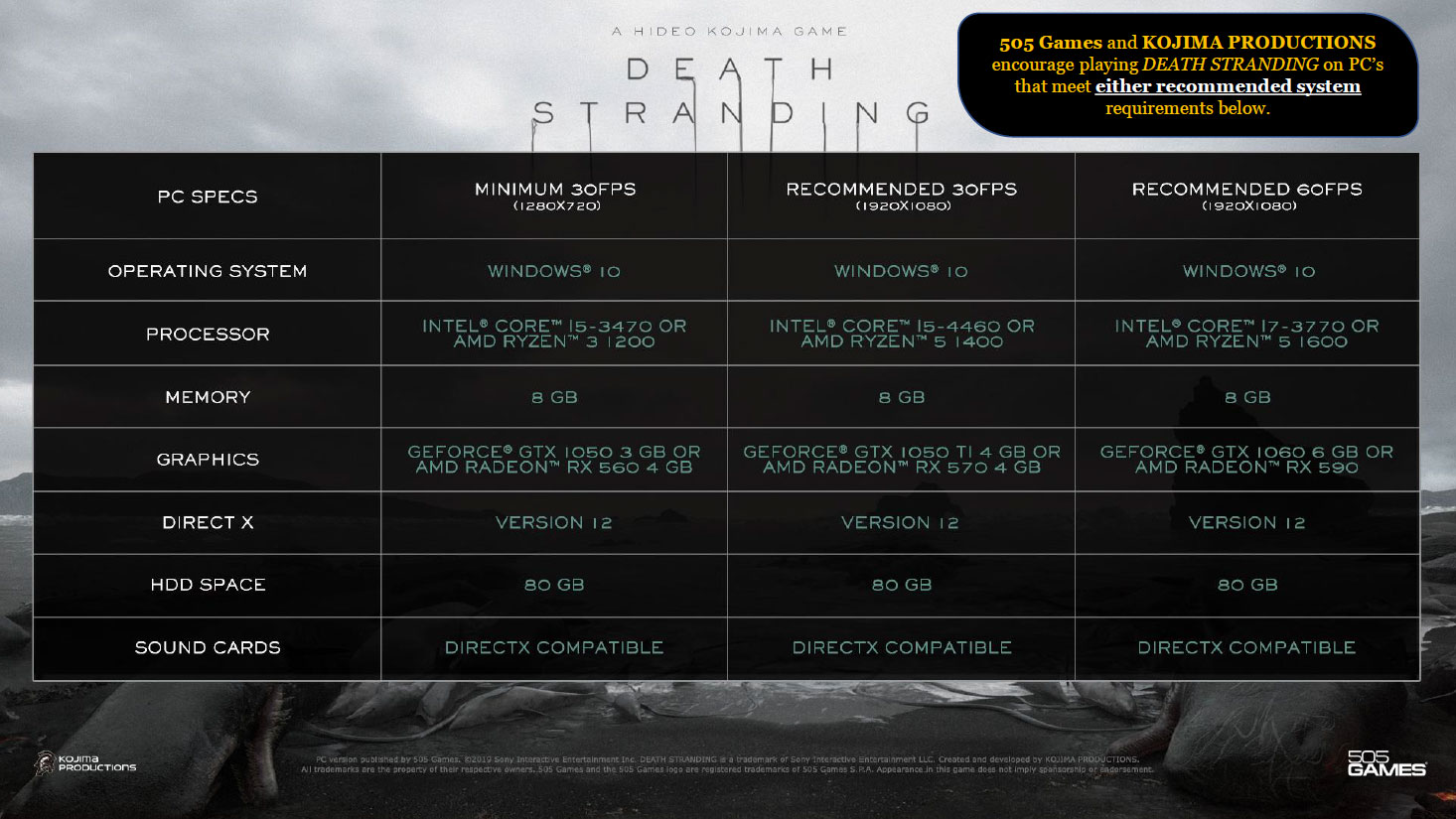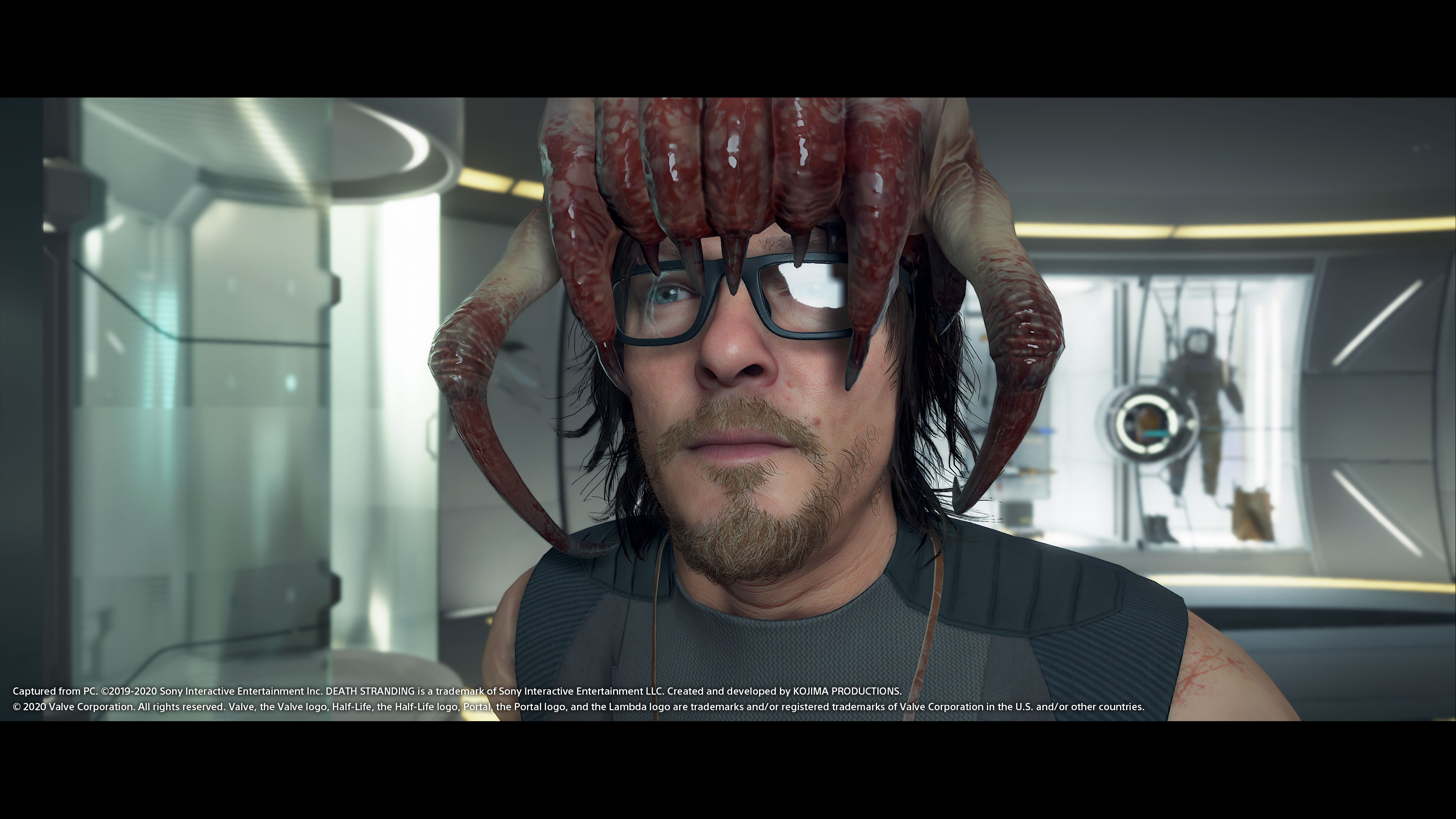Death Stranding With DLSS 2.0 Allows for 4K and 60 FPS on Any RTX GPU
Death Stranding comes to PC on July 14, but we were able to do some preliminary early access testing.
Death Stranding, Hideo Kojima's wild game of package delivery and social networking likes, arrives on PC this July 14. In a strange move, however, we're not allowed to show you videos or images of the PC version yet. We have the above pre-order video, and Nvidia was able to provide us with a few 4K DLSS screenshots, but apparently 505 Games and Kojima Productions don't want anyone to spoil the story — never mind the fact that the game has been out for eight months on PlayStation 4. But we can share some initial impressions, and that means some early benchmarking from yours truly.
The PC version adds a photo mode along with ultrawide resolution support. It also has an unlocked framerate (sort of — there's a 240 fps limit still, though we couldn't get there at 1080p without dropping settings quite a bit), a few graphics options to tweak, and enhanced visuals compared to the console release. There's also a Half-Life themed quest of sorts, and you can now see Norman Reedus in even more 'breathtaking' detail! But I digress.
For testing of the early access build, I ran Death Stranding on my standard GPU test system, which consists of the high-end hardware you can see in the boxout to the right. Kojima Productions and 505 Games say the game is a "visual powerhouse" and are apparently restricting access to game reviewers to people who have the recommended hardware. Which might sound bad, until you see the recommended specs:
I don't have hardware that's old enough or slow enough to verify the 720p performance, but a GTX 1060 6GB or RX 590 aren't exactly extreme components these days, and lots of graphics cards will beat a GTX 1050 Ti or RX 570. The CPU requirements also look pretty tame, and while the minimum lists an i5-3470 or Ryzen 3 1200, you can likely run it on something older or slower as well.
This isn't our full performance analysis, since we only have an early access build and potentially unoptimized drivers. We'll hold off on additional testing of GPUs and CPUs until the full release, but in the meantime we wanted to check out performance as well as DLSS 2.0. Let's start with the latter.
DLSS 2.0 is the 'universal' implementation of Nvidia's DLSS technology (that's Deep Learning Super Sampling if you haven't heard of it), with lower performance overhead, more flexibility, and better overall image quality. Those are Nvidia's claims, at any rate, and in Death Stranding we can't see any reason to dispute the matter.
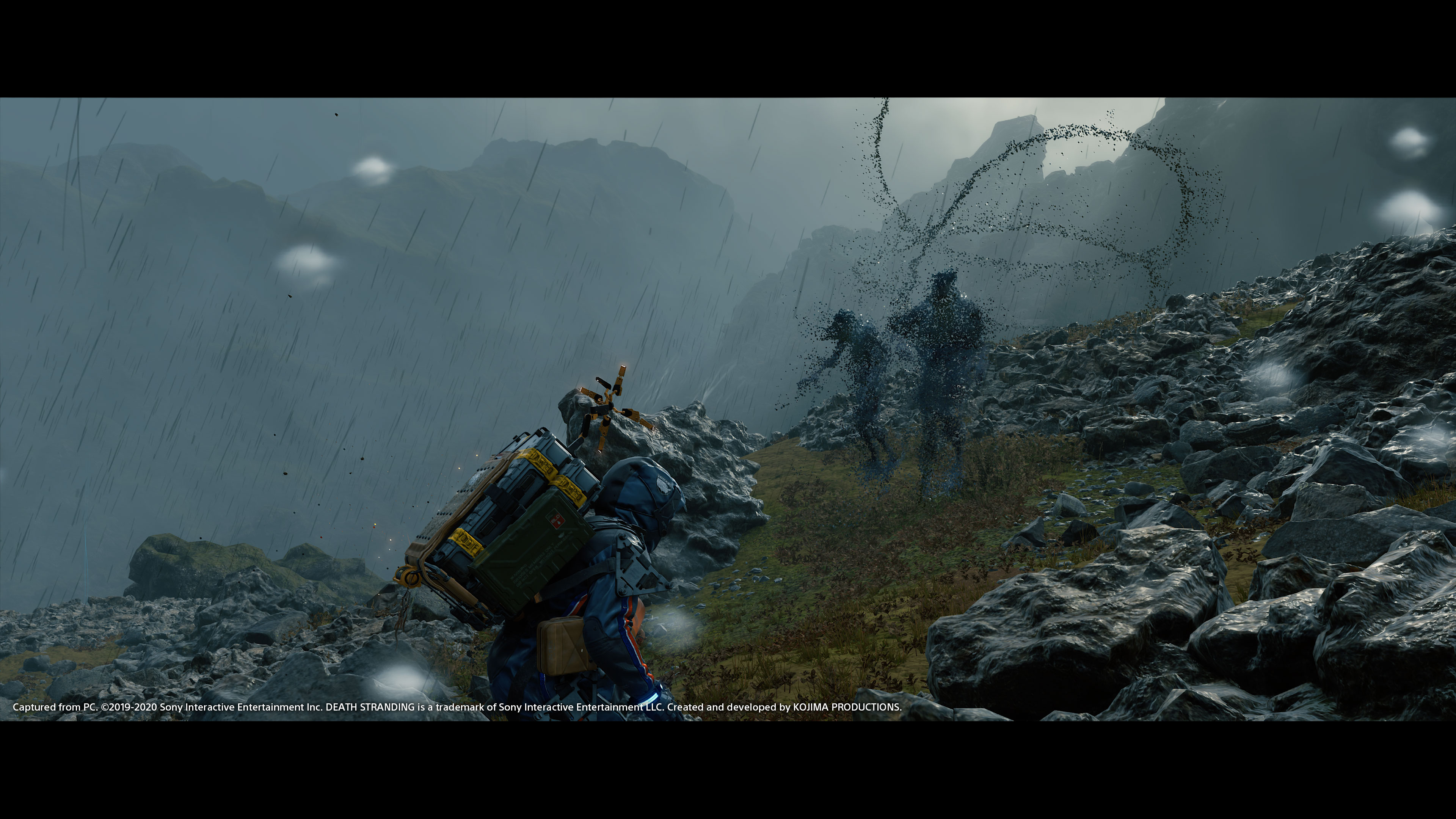
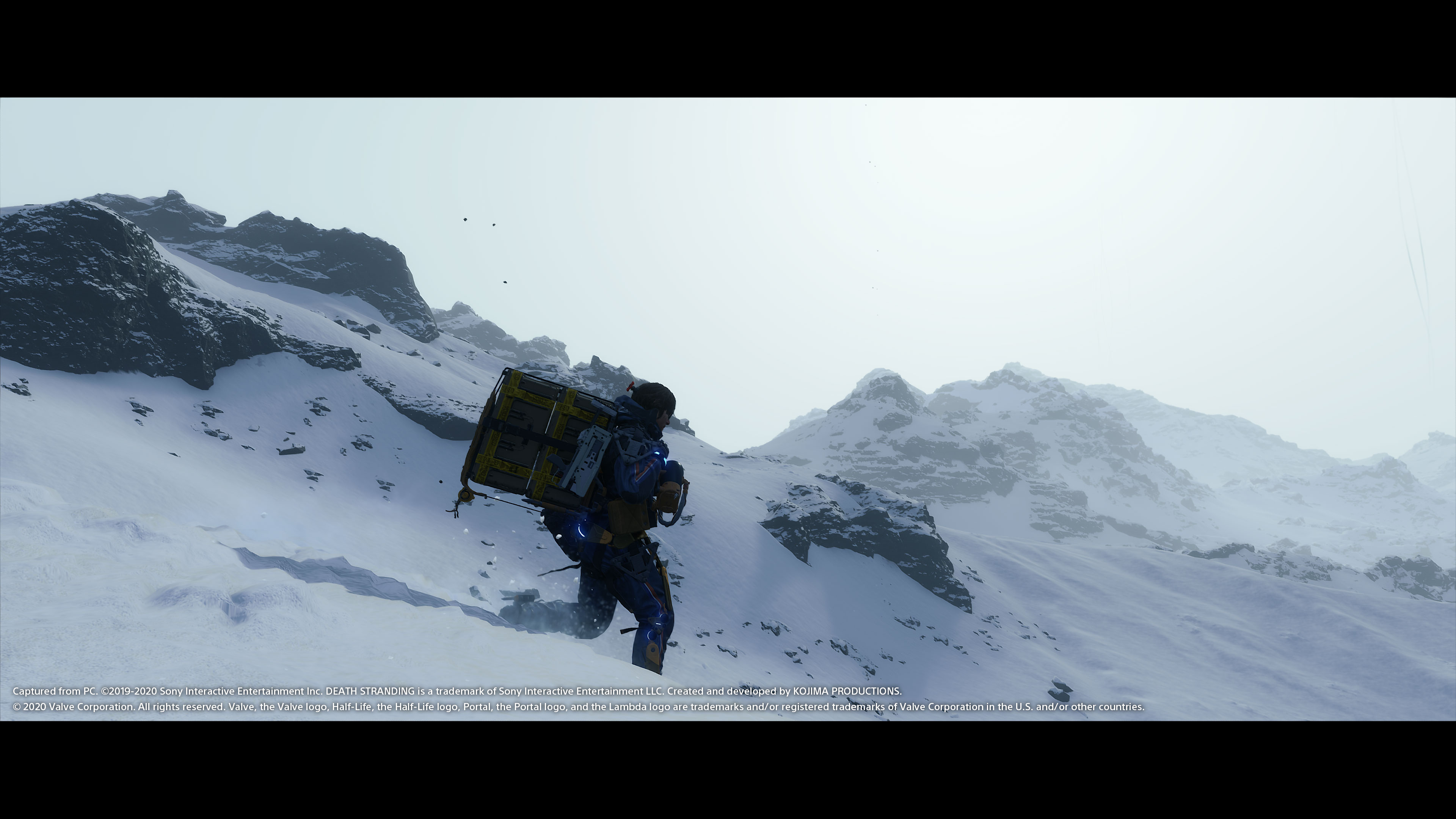
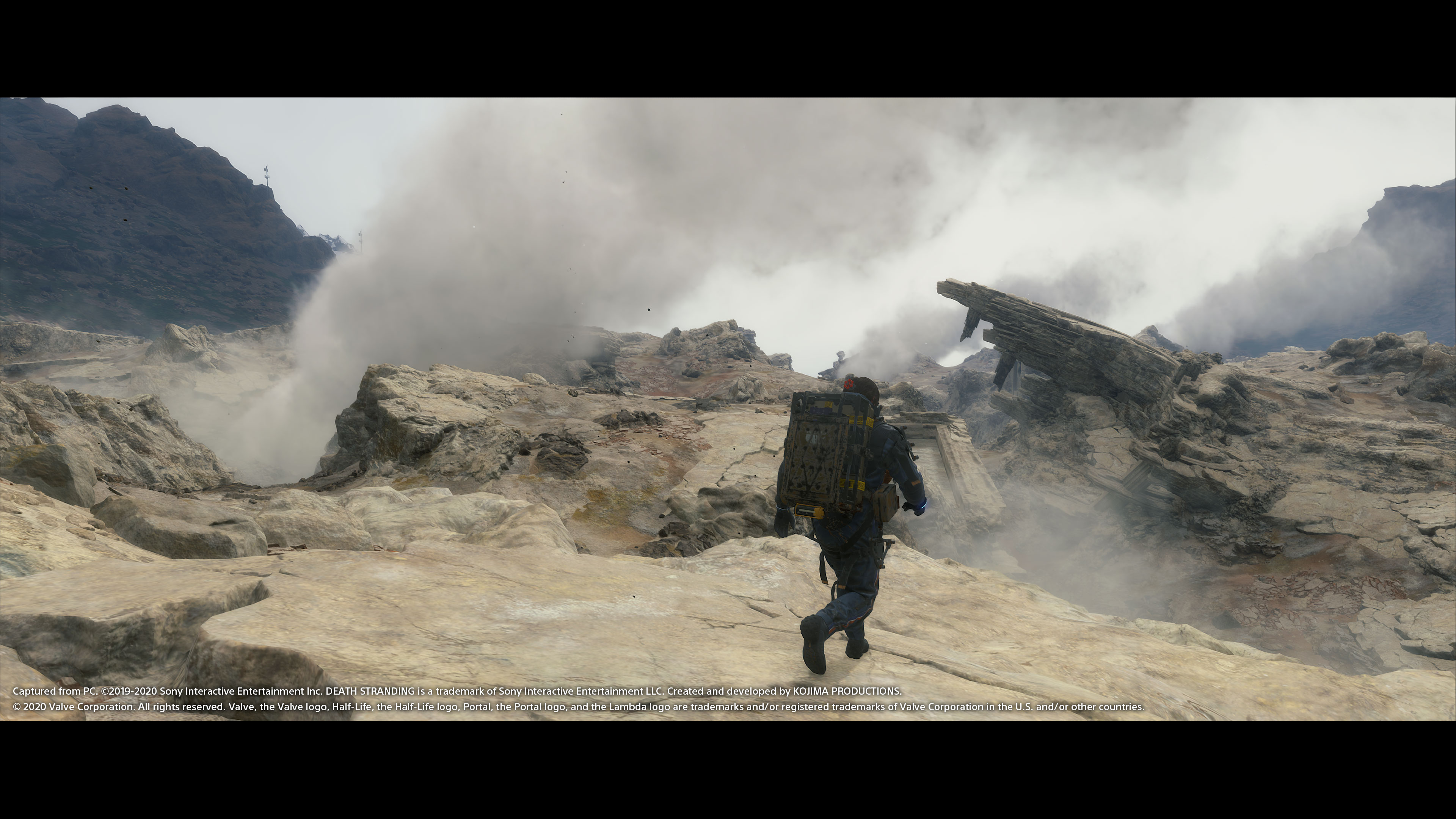
As far as image quality goes, playing the game with and without DLSS, I couldn't tell whether it was on or off without looking at the settings or framerate. I've even got screenshots taken with DLSS using both the quality and performance modes, along with no DLSS and TAA (Temporal Anti-Aliasing). The performance mode looks just a tad worse, though at higher resolutions it's far less noticeable. Against TAA, I think DLSS quality mode looks better, partly because TAA tends to over blur things.
Get Tom's Hardware's best news and in-depth reviews, straight to your inbox.
Death Stranding also supports AMD's FidelityFX CAS, aka Contrast Aware Sharpening. In other games, I've found the overall effect pleasing, but Death Stranding isn't just using FidelityFX for sharpening; it also does upscaling. Basically, it's a post-processing filter that does similar work as DLSS, only you don't need an RTX card. The problem is that — at least in the preview build — the sharpening and upscaling causes some visible shimmer. It's not terrible, and it's a way to boost framerates that some people will undoubtedly appreciate, but the effect was certainly noticeable when moving around.
We'd love to provide images of the various modes, but that will have to wait. Also, we can't provide images without letterboxing for now. Yes, the PC version support ultrawide resolutions, but we need the legal disclaimers.
Moving on to performance, DLSS as usual makes less of a difference on the fastest RTX GPUs, particularly at lower resolutions. The RTX 2080 Ti basically performed the same at 1080p with or without DLSS (DLSS was 2% faster), hitting an apparent CPU limit of around 160-165 fps. At 1440p, DLSS quality mode provided a more noticeable 23% boost in framerates (156 fps vs. 127 fps), while at 4K it delivered a 34% improvement (105 fps vs. 78 fps). We didn't test the RTX 2080 Ti in DLSS performance mode, as Death Stranding isn't the sort of game that really needs much more than 60 fps, and at 4K it's already well above that mark.
The RTX 2060 is the bottom of the RTX line, and it benefited more from DLSS at lower resolutions. DLSS quality mode improved performance at 1080p from 103 fps to 128 fps, a 25% increase. 1440p went from 75 fps to 100 fps (33% faster), and 4K improved from 43 to 56 fps (31%). It looks like DLSS quality mode can boost performance by 30-35% overall, provided you're GPU limited. What about DLSS performance mode? That was enough to take even the RTX 2060 above 60 fps (77 fps to be precise) at 4K. Obviously there's a lot less rendering work going on, since DLSS performance mode renders at half the vertical and horizontal resolution (so 4K DLSS performance is 1080p with DLSS upscaling). Still, unless you're pixel peeping it's difficult to see the difference between the various upscaling modes at 4K.
I did run some tests with an RX 5700 XT as well. Performance was fine, but there were clearly some bugs that need fixing. The default TAA mode for example didn't work, so everything looks full of jaggies. FidelityFX CAS did clean things up for the most part, but performance was slightly lower than the base settings, suggesting the upscaling aspect wasn't working right. Still, 4K at 60+ fps was possible on the RX 5700 XT (it got 76 fps with the broken TAA, and 71 fps with FidelityFX), so Death Stranding shouldn't have any trouble running at lower resolutions on various AMD GPUs.
We'll be back with a more in-depth look at performance and image quality once the retail release of Death Stranding is available. For now, it looks like it will run very well on any RTX GPU at 4K, provided you enable DLSS. AMD's GPUs should also do fine with FidelityFX, though with slightly lower image quality. Or you can skip both upscaling options and just run the game at native. Most decent GPUs should be able to handle at least 1080p with the very high (maximum quality) preset, and high-end graphics cards shouldn't have any trouble with 1440p.
If you've been waiting to compete for social networking likes in a tripped out post-apocalypse version of America on PC, Death Stranding should scratch that itch in a couple of more weeks.

Jarred Walton is a senior editor at Tom's Hardware focusing on everything GPU. He has been working as a tech journalist since 2004, writing for AnandTech, Maximum PC, and PC Gamer. From the first S3 Virge '3D decelerators' to today's GPUs, Jarred keeps up with all the latest graphics trends and is the one to ask about game performance.
-
hannibal Well dlss 4k is not 4k but up-scaled, But if done right it does not look too bad anymore!Reply
So more interested in seen if it has been done so that it does not look bad or... -
JarredWaltonGPU A few other thoughts about the game:Reply
1) It's super weird. I've played perhaps a dozen hours of it now, and it's either going to end up being some sort of weird allegory for the afterlife (like Kentucky Route Zero), or it's going to be complete nonsense mystical mumbo jumbo. I'm guessing the latter. I would not call it a masterpiece -- weird for the sake of being weird, more like, with lots of walking around picking up packages in between. The whole BB thing (Bridge Baby, an 28 week old baby in a bottle on your chest that detects BTs) for example. Why? Whatever.
2) The United Cities of America premise is also goofy, as the landscapes look nothing like the US. Also, you walk about four km in the first two chapters of the game, connecting people up with likes to the Chiral network. Except, the map shows that you've apparently covered most of the eastern US. I get not making the game to scale ... but it's ludicrous to set it in "the former US" where the entire country is apparently only 10-12 km across.
3) The corporate tie ins are nuts, along with all the "here's the real actor playing this particular character" blurbs. Do we really need to know who plays Deadman, or Die-Harder? It's constantly breaking the wall. Monster Energy drinks, Hollywood B-list celebrities, Half-Life stuff, and I don't know what else.
4) Constant unskippable cutscenes suck. They suck SO BAD! The first time you encounter a BT, you're treated to BB freaking out for 15 seconds alerting you to their presence. You can have the game do this EVERY time if you're a masochist. The elevators, private quarters, etc. do have the option to skip forward, but there's a ton of skipping required. Every successful delivery requires about 30 seconds of clicking through the same old nonsense to find out how many 'likes' you got. Just ... ugh. Clearly not for me.
I'm sure some people will love it. I'm personally curious to see where it goes. But for all the fawning over Hideo Kojima, this game has some clear flaws. It looks pretty, and it's not bad, but if you stripped out a bunch of garbage cutscenes that repeat so often it's maddening, you could make this a 20 hour game instead of a 40-50 hour game.
Also, I accidentally drove my first reverse trike into deep water. (Rivers have blue, yellow, and red indicators for how deep the water is, but I crossed at a point where it was red not realizing this.) I apparently am now stuck on foot until episode 3 in the game, which sucks. You get a trike to use as much as you want ... unless you break it and then it's gone until you progress. Can't you just put a new trike back in the garage? Or recover it? Bleh. -
CatalyticDragon ReplyJarredWaltonGPU said:... complete nonsense mystical mumbo jumbo.
That's what you get with a Kojima game. -
CatalyticDragon ReplyAdmin said:The performance mode looks just a tad worse, though at higher resolutions it's far less noticeable
By definition if it's using upscaling then it's not 4K. Naturally the closer you get to native resolution the better the image quality will be so it'll be good to see those side by side comparisons. -
nitrium I gather it's not quite as divisive as The last of Us 2, but is this game actually any good on a mechanical level? Is it "fun"? Does it have a good story? I read somewhere the actual good part of the game starts about 20 hours in or something(?).Reply -
Chung Leong ReplyCatalyticDragon said:By definition if it's using upscaling then it's not 4K. Naturally the closer you get to native resolution the better the image quality will be so it'll be good to see those side by side comparisons.
Computer graphics is all about illusions, duh. If the eyes perceive it as 4K then it is 4K. -
bit_user Reply
As a non-gamer, I find reviews like this very reassuring. Thanks for sharing.JarredWaltonGPU said:A few other thoughts about the game: -
bit_user ReplyCatalyticDragon said:By definition if it's using upscaling then it's not 4K. Naturally the closer you get to native resolution the better the image quality will be so it'll be good to see those side by side comparisons.
Interesting debate. I think you each have a point.Chung Leong said:Computer graphics is all about illusions, duh. If the eyes perceive it as 4K then it is 4K.
The fundamental problem with scaling is that it doesn't truly add information. So, there will be fine details that are missing from even the best upscaling. DLSS seems to do a lot to minimize the downsides of scaling, but it certainly can't match native rendering.
The point about the eyes perceiving 4k seems a little off, because eyes don't really work like that. Rather, it's just a variation on the argument of "good enough". And that's the point - if it's good enough that it offers a visual improvement over gaming at native 1440p, for instance, then maybe you just be happy and play the game. There's a lot of wisdom in that, but what's good enough for one player might not suffice for another.
Maybe someone is sitting right in front of a 55" display, where they can really see the finer details. I wouldn't try to tell that person that they should be as happy with upscaling as someone playing on a 28" 4k monitor. There are other factors, but display hardware is probably the biggest one. -
4r7hur Reply
Not exactly, the difference between 1080p-4k is much bigger than 720p-1080p or 540p-1080p, if it's the same with Control the DLSS Performance should be 1080p-4k and 1440p-4k for DLSS Quality.CatalyticDragon said:By definition if it's using upscaling then it's not 4K. Naturally the closer you get to native resolution the better the image quality will be so it'll be good to see those side by side comparisons. -
Chung Leong Replybit_user said:The fundamental problem with scaling is that it doesn't truly add information. So, there will be fine details that are missing from even the best upscaling. DLSS seems to do a lot to minimize the downsides of scaling, but it certainly can't match native rendering.
There's a video on Youtube showcasing Control with DLSS 2.0. The screenshot for 540p with DLSS actually seems to have more details than the one for 1080p native.
AI is basically pattern recognition. When the computer recognizes that a bunch of pixels are supposed to represent a particular shape, it can scale the image to any resolution. In a way it's like OCRing a scanned document, where the output would have less raw information but yield superior results when printed.

